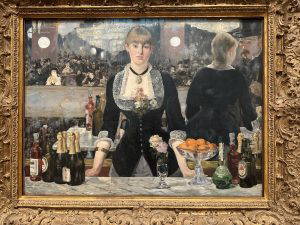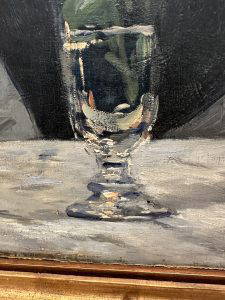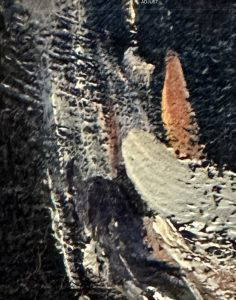We visited the Courtauld Gallery yesterday, where I stood admiring Manet’s painting, A Bar at the Folies-Bergère, for some time. There is a glass on the counter.

As I examined the glass more closely, I marvelled at the detail, how perfect the glass was, how it reflected the light as a glass would.

As I zoomed in ever closer, to the individual brushstrokes, I wondered how I could see a glass at all.

I suppose the miracle of art is the relationship between the artist and the audience. I have two particular favourite styles of visual art. One is the minimalist style, where with perhaps half a dozen brushstrokes, a horse is painted. The other is the work of M.C. Escher, where staircases never end, our perception is fooled. What Escher has done so magnificently is to exploit the representation of a three dimensional world on a two dimensional canvas. The viewer has to see the art in three dimensions, but Escher plays with the normal rules.
There is a phenomenon known as Boundary Extension, where the brain extrapolates beyond what the eye has seen. I came across an article in The Smithsonian, which explored how the brain processes art. Apparently looking at a wrist triggers motor impulses in the viewer’s brain which controls their own wrist. Viewing Degas’ ballerinas makes some viewers feel the sensation of dancing.
I posted recently about brevity in writing. The challenge for a writer is to find the best words to evoke the desired experience in the reader. I love the way Raymond Chandler does that. Try this from Farewell My Lovely. “It was a blonde. A blonde to make a bishop kick a hole in a stained-glass window.” I had Chandler in mind while trying to describe Galileo’s study in Fire and Earth. “It was the sort of room that spiders love and cleaners don’t.” OK, I’ve got to keep working on my brushstrokes. But Fire and Earth was only the second book in the Sir Anthony Standen Adventures. The fourth book, Called to Account will be published on 8th November.
